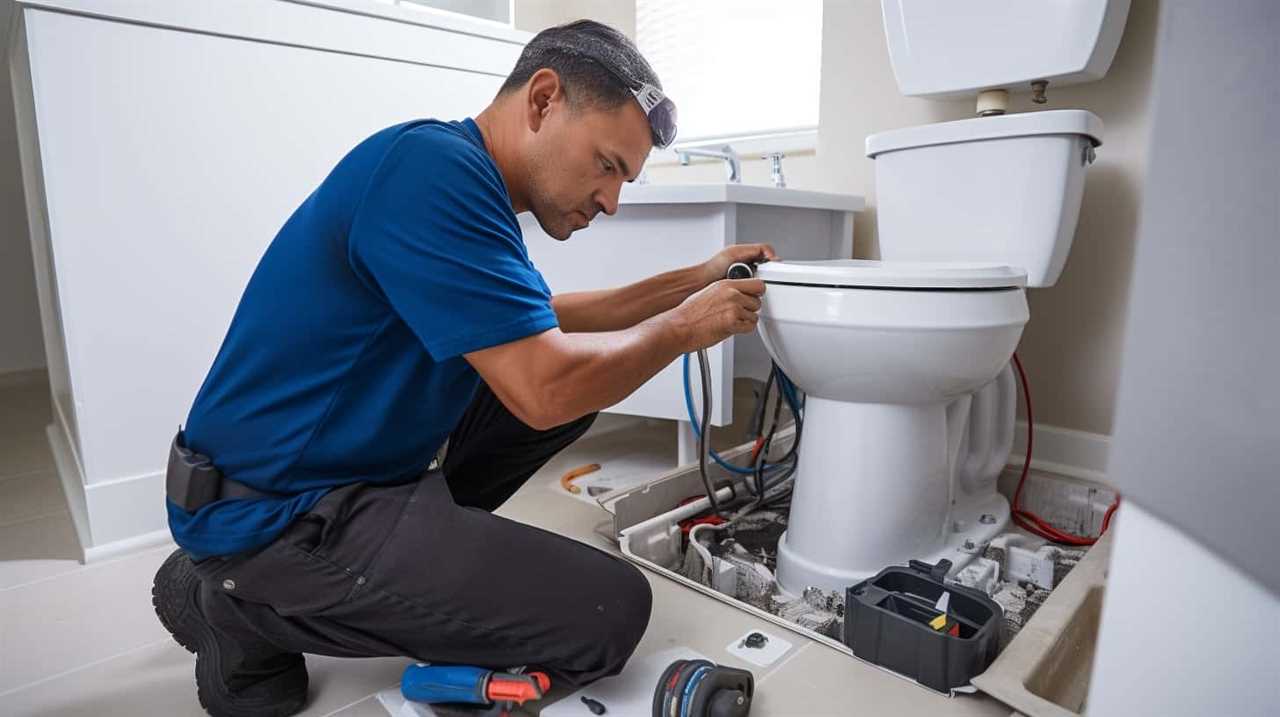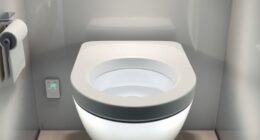Picture the effectiveness of two bathroom exhaust fans, operating together to eliminate excess moisture and odors.
In this article, we explore the possibility of sharing the same outside duct for these fans. We delve into the benefits and drawbacks, as well as provide considerations and tips for a successful shared duct installation.
So, whether you’re a homeowner seeking mastery over your ventilation system, or a professional installer looking for the best solution, this article is for you.
Let’s dive in.

Key Takeaways
- Sharing a duct for bathroom exhaust fans can provide cost savings, improved energy efficiency, and prevent heat loss.
- However, there are drawbacks such as reduced airflow, noise transfer, and inadequate odor control.
- Proper considerations and installation techniques, such as sizing the duct correctly and balancing airflow, are crucial for successful shared duct installation.
- Factors to consider before deciding to share a duct include budget, space constraints, ventilation needs, noise tolerance, and personal preferences.
Benefits of Sharing a Duct
Sharing a duct for multiple bathroom exhaust fans offers several benefits.
One of the main advantages is cost savings. By using a single duct, you can reduce the amount of materials needed for installation, such as ducting and vent covers. This can result in significant cost savings, especially if you have multiple bathrooms in your home.
Additionally, sharing a duct can improve energy efficiency. When multiple fans are connected to the same duct, they can work together to expel the moist air more efficiently, reducing the overall energy consumption. This is especially important in areas where energy costs are high.
Drawbacks of Sharing a Duct
Despite the cost savings and improved energy efficiency discussed earlier, there are some drawbacks to connecting multiple bathroom exhaust fans to the same outside duct. While sharing a duct may seem like a convenient solution, it can lead to potential issues and disadvantages that should be considered.

Here is a table summarizing the drawbacks of sharing a duct for bathroom exhaust fans:
| Drawbacks | Potential Issues |
|---|---|
| 1. Reduced airflow | – Insufficient ventilation in one or more bathrooms – Increased risk of mold and mildew growth |
| 2. Noise transfer | – Noise from one bathroom can be transmitted to other areas of the house – Disruption of privacy and comfort |
| 3. Inadequate odor control | – Odors from one bathroom can spread to other areas – Unpleasant living environment |
| 4. Difficulty in maintenance | – Increased complexity in cleaning and maintenance tasks – Higher likelihood of clogs and blockages |
| 5. Limited customization | – Inability to adjust fan settings independently for each bathroom – Lack of control over ventilation requirements |
Considering these drawbacks, it is important to carefully evaluate the feasibility and potential consequences of a shared duct installation.
Considerations for Shared Duct Installation
To continue the discussion on connecting multiple bathroom exhaust fans to the same outside duct, we should consider some important factors for shared duct installation.
When installing a shared duct system, there are several installation challenges to be aware of. Firstly, the duct size must be properly calculated to ensure adequate airflow for all the fans. Additionally, it’s crucial to install dampers to regulate the airflow and prevent backdrafts.

Maintenance considerations should also be taken into account. Shared duct systems require regular cleaning to prevent the buildup of dust and debris, which can impede airflow and decrease the effectiveness of the exhaust fans. Furthermore, regular inspections should be conducted to identify and address any potential leaks or obstructions in the shared duct.
Tips for Properly Sharing a Duct
When connecting multiple bathroom exhaust fans to the same outside duct, there are a few tips we should keep in mind for properly sharing the duct. To avoid common mistakes and ensure proper maintenance, follow these guidelines:
| Tips for Properly Sharing a Duct | |
|---|---|
| 1. Sizing | Ensure the duct is large enough to handle the combined airflow of all the fans. Calculate the required duct size based on the total CFM (cubic feet per minute) of the fans. |
| 2. Balancing | Properly balance the airflow between the fans to ensure equal ventilation in each bathroom. Use dampers or adjustable vents to control the airflow. |
| 3. Maintenance | Regularly clean and inspect the duct to prevent clogs and obstructions. Clear any debris or buildup that may affect the performance of the fans. |
Conclusion: Is Sharing a Duct Right for You?
Based on the tips for properly sharing a duct, we can assess whether sharing a duct for bathroom exhaust fans is the right choice for our specific needs. Before making a decision, it’s important to consider the pros and cons of this setup.
Pros:

- Cost-effective: Sharing a duct reduces the need for additional ductwork, saving both time and money during installation.
- Space-saving: With multiple fans sharing the same duct, there’s no need for multiple exhaust vents, allowing for a more streamlined and aesthetically pleasing bathroom design.
- Efficient airflow: By sharing a duct, the fans can work together to maintain proper ventilation, ensuring effective removal of moisture and odors.
Cons:
- Limited control: Sharing a duct means that all the fans will operate simultaneously, so individual control over each fan may be limited.
- Noise concerns: With multiple fans running through the same duct, there may be an increase in noise levels, which can be disruptive in a bathroom setting.
- Maintenance challenges: Cleaning and maintaining a shared duct may be more complicated, as it requires access to all the fans connected to the duct.
Ultimately, the decision to share a duct for bathroom exhaust fans depends on factors such as budget, space constraints, and personal preferences. It’s important to weigh the pros and cons and consider the specific installation process before making a final decision.
Frequently Asked Questions
How Much Does It Cost to Install a Shared Duct for Bathroom Exhaust Fans?
When considering the installation of a shared duct for bathroom exhaust fans, it is important to factor in the cost comparison and the installation process. This allows for a more efficient and cost-effective ventilation system.
Can I Install a Shared Duct for Bathroom Exhaust Fans in an Apartment Building?
Installing a shared duct for bathroom exhaust fans in an apartment building has pros and cons. While it saves on installation costs, it may impact indoor air quality by spreading odors and contaminants.

What Are the Potential Fire Hazards Associated With Sharing a Duct for Bathroom Exhaust Fans?
Sharing a duct for bathroom exhaust fans can pose potential fire hazards and safety concerns. It is important to consider the risk of airflow obstructions, accumulation of lint and debris, and the potential for backdrafting.
Are There Any Building Code Requirements or Regulations That Need to Be Followed When Installing a Shared Duct for Bathroom Exhaust Fans?
Building code requirements and regulations must be followed when installing a shared duct for bathroom exhaust fans. Compliance with these rules ensures proper ventilation and safety standards are met.
Can a Shared Duct for Bathroom Exhaust Fans Affect the Airflow and Efficiency of Each Individual Fan?
Sharing a duct for bathroom exhaust fans can impact the airflow and efficiency of each fan. The ventilation system may become less effective due to restricted airflow and increased back pressure.
Conclusion
In conclusion, sharing a duct for bathroom exhaust fans can be a practical solution for maximizing ventilation efficiency and reducing installation costs.

However, it’s crucial to consider the drawbacks, such as potential airflow restrictions and increased noise levels. Proper installation and regular maintenance are essential to ensure optimal performance.
Ultimately, the decision to share a duct should be based on individual needs and circumstances.









